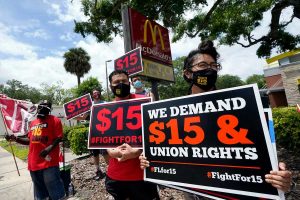America's Biggest Companies Are Systematically Short-Changing Workers

Work sucks, and the pay is too low. This is almost a universal constant in America, but for many workers at some of the biggest food service and retail companies in the U.S., it’s a matter of corporate policy to pay people well below a living wage, according to a new study.
A new company wage tracker designed by the Economic Policy Institute and the Shift Project took a closer look at 66 of America’s biggest food and retail companies. Some of the results are staggering, and provide a striking window into what it’s like to work at some of the largest chains in America. Dollar General, for instance, pays 92 percent of their workers below $15. McDonald’s is at 89 percent. At both of these companies, more than 1 in 5 workers makes below $10 per hour. These are poverty wages, but they’re sadly the norm, especially in communities where these big chains have driven out other competitors. Dollar General embarked on a nationwide expansion in largely underserved rural communities, filling the gaps wherever communities weren’t dominated by local Walmarts (where 51 percent of workers make under $15 per hour, and 91 percent make under $20 per hour).
The tracker itself is public, and allows you to compare the percentages of employees who make below certain thresholds at each of the companies. Rolling Stone’s analysis of the data shows that only 22 of the 66 companies listed pay 50 percent or more of their employees more than $15 per hour. The other 44 companies pay the majority of their workers less. The $15 minimum wage has been shot down in Congress multiple times thanks to Democratic incompetence and Republican obstinance, but it is still widely recognized as the bare minimum for workers living in today’s society.
Workers across the country have attempted to organize in various ways to bring about this change themselves, most prominently through the Fight for $15 campaign and the new wave of unionization that has targeted some of the biggest firms on this list. At Starbucks, for instance, where 63 percent of workers make under $15 per hour, individual stores are consistently voting to unionize with the independent Starbucks Workers United. The company has responded with ruthless union-busting, firing at least 18 pro-union workers since February, according to new reporting by Vice News. But at chains with even worse wages, like McDonald’s and Dollar General, relentless turnover prevents workers from building union movements. A pre-pandemic study found that workers were twice as likely to quit when they were paid the federal minimum wage of $7.25 per hour.
Some companies, like Amazon and its subsidiaries, have self-imposed large minimum wage hikes, bringing almost all of their workers to above $15 per hour. This may seem like altruism, but it’s actually a calculated decision in order to weaken the overall goals of employees seeking to unionize. It’s a good reminder that even $15 an hour doesn’t solve the inherent exploitation that the major chains on this list depend on to pump up their profit margins. It only forces them to extract more from their workers through other means, like Amazon’s punishing productivity quotas.
If you need this point driven home any further, click on any of the companies in the tracker and take a quick look at the “Revenue” and “CEO Pay” lines. The latter is always a lot more than $15 per hour.
Source: Read Full Article
